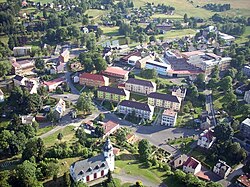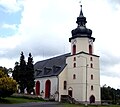Hranice (Cheb District)
Hranice | |
|---|---|
 Aerial view of Hranice | |
 Flag  Coat of arms | |
 Hranice Location in the Czech Republic | |
| Coordinates: 50°18′17″N 12°10′33″E / 50.30472°N 12.17583°ECoordinates: 50°18′17″N 12°10′33″E / 50.30472°N 12.17583°E | |
| Country | |
| Region | Karlovy Vary |
| District | Cheb |
| First mentioned | 1413 |
| Government | |
| • Mayor | Daniel Mašlár |
| Area | |
| • Total | 31.79 km2 (12.27 sq mi) |
| Elevation | 575 m (1,886 ft) |
| Population (2021-01-01)[1] | |
| • Total | 2,151 |
| • Density | 68/km2 (180/sq mi) |
| Time zone | UTC+1 (CET) |
| • Summer (DST) | UTC+2 (CEST) |
| Postal code | 351 24 |
| Website | www |
Hranice ([ˈɦraɲɪtsɛ], German: Roßbach) is a town in Cheb District in the Karlovy Vary Region of the Czech Republic. It has about 2,200 inhabitants. It lies on the border with Germany.
Administrative parts[]
Villages of Pastviny, Studánka and Trojmezí are administrative parts of Hranice.
Etymology[]
The old German name Rossbach means "Horse brook", referring to the brook where first inhabitants watered their horses. Therefore the horse appears on the town's coat of arms and flag.[2]
In Czech, Hranice means "border". Following the partition of Germany, a border tripoint (between Czechoslovakia, West and East Germany) was situated near the town, for which the village of Trojmezí (literally "Tripoint") is named. In fact, the village is also the tripoint of the three historical regions of Bohemia, Bavaria and Saxony.
Geography[]
Hranice lies twelve kilometres north of Aš, in the northernmost part of the region, at about 575 meters above sea level. It neighbors the German municipalities of Bad Elster to the southeast, Adorf to the northeast, Eichigt to the north, Regnitzlosau to the west, and Rehau to the southwest.
History[]
The town was probably founded at the turn of 12th–13th century. The first unverified mentions of the town comes from the beginning of the 14th century. The first verified written mention of Hranice dates to 1413, when the town was bought by the House of Zedtwitz.[2] Before that time, Hranice was the property of the Neippergs. At the end of the 14th century, the Neippergs ran into financial trouble and sold the town. The House of Zedwitz controlled Hranice and the whole region around Aš for almost 500 years.
In 1542, Lutheranism first appeared in the village. In 1633, the bubonic plague killed forty people in the town.[citation needed]
In 1822 a new school was built. In 1850, a post office was opened and in 1868, the first fire squad was established. In 1882, Hranice gained market rights and became a market town.[2]
Textile industry[]
In the 19th century, the textile industry expanded rapidly in the region, including in Hranice. Beginning in 1806, a local textile factory was one of the most successful in Bohemia. In 1840, however, a plan to build a new road through the town was rejected by the local council. Because Hranice had no railway connection and only bad roads, the textile industry there began to decline. Two new railway routes – one from Aš to Hranice (established in 1885) and the other from Hranice to Adorf (established in 1906) – helped local industry greatly.
Sights[]
Notable buildings in Hranice include the Evangelic Church, built in the 17th century, and the Catholic Church of the Visitation of the Virgin Mary, built in 1894.[2]
Hranice contains a World War I memorial, built in 1928, along with a World War II memorial and a memorial to a Royal Air Force pilot who crashed in the area during World War II.
Notable people[]
- Rudolf Dölling (1902–1975), major general of the National People's Army in the German Democratic Republic and ambassador to the Soviet Union
Gallery[]

Evangelic Church

WW1 memorial

Train station
References[]
- ^ "Population of Municipalities – 1 January 2021". Czech Statistical Office. 2021-04-30.
- ^ Jump up to: a b c d "Historie" (in Czech). Město Hranice. Retrieved 2021-06-07.
External links[]
| Wikimedia Commons has media related to Hranice (Cheb District). |
- Populated places in Cheb District
- Cities and towns in the Czech Republic



